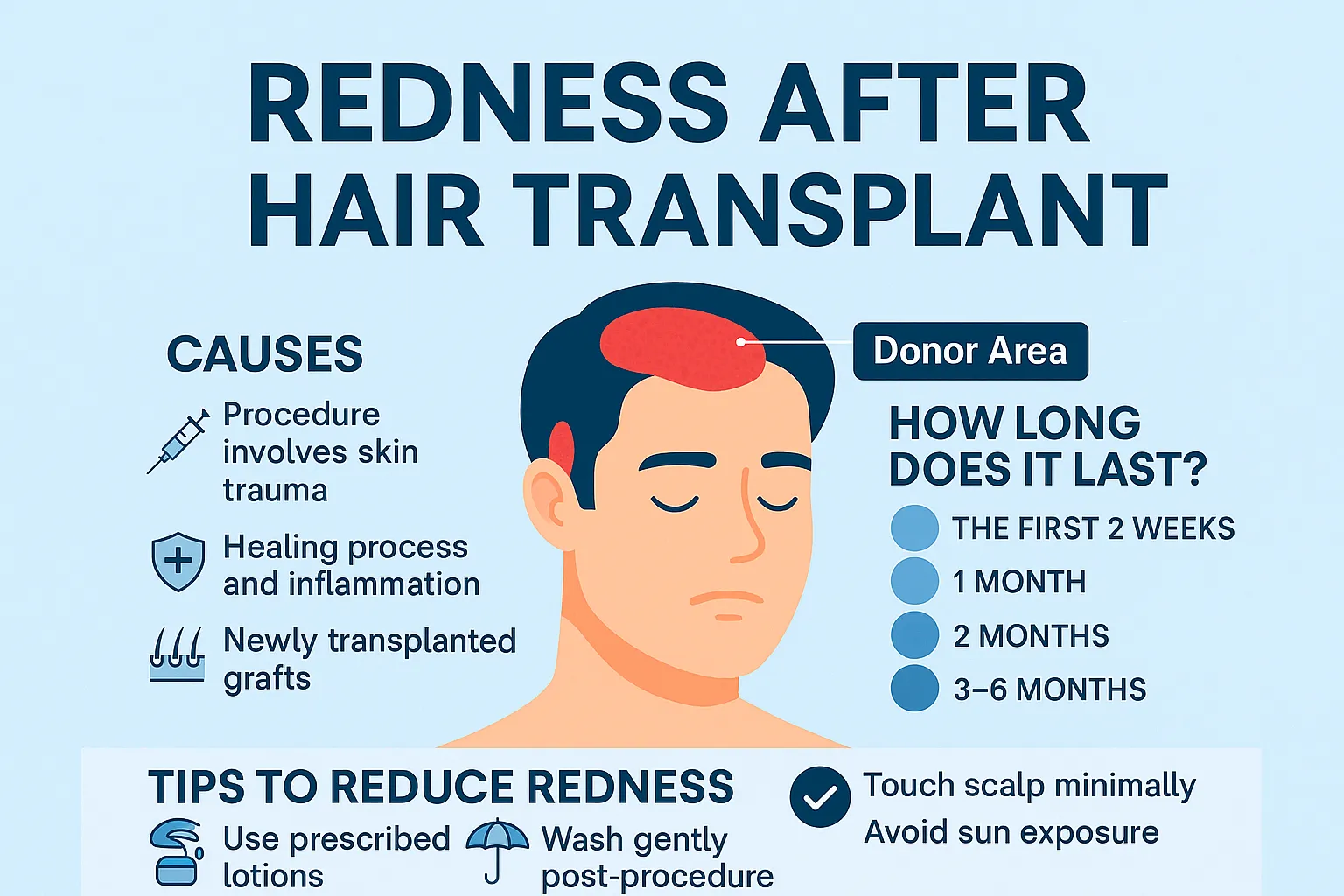Hair Transplant Redness – What’s Normal and When to Worry
A hair transplant is a powerful solution for restoring confidence and reversing hair loss. However, one common side effect is redness after hair transplant, particularly in the transplanted and donor area. This visible reaction is part of the natural healing process, but knowing what’s expected and what’s not can ease concerns and support a smooth recovery.
What Is the Cause of Redness After Hair Transplant Procedure?
Redness after hair transplant is caused by the body’s response to minor trauma inflicted during the hair transplant operation. Both FUE hair transplant and DHI hair transplant techniques involve creating micro-incisions to insert hair follicles. These incisions activate the immune system and increase blood flow to the scalp, causing visible redness.
This is also an indicator that healing has begun. Inflammation and redness help clean the area and support regeneration of the skin. The intensity of redness can vary from person to person, depending on the number of grafts, the technique used, and individual skin sensitivity.
Is Redness After Hair Transplant Normal?
Yes, this is a completely natural phase of the healing process. Most patients experience redness and minor swelling in the donor area and the transplanted area for the first two weeks. It is the skin’s way of adapting to trauma and supporting the growth of new hair.
The redness can appear more pronounced in individuals with light or sensitive skin, and especially if a high number of grafts were implanted.

How Long Does Redness Last After Hair Transplant Surgery?
Patients often ask: how long does redness last after hair transplant?
- The first 7–14 Days: Bright redness, sensitivity, and scabs may appear.
- Weeks 3–4: Redness starts to fade. Hair follicles begin to grow.
- After 1 Month: Most people notice only mild pinkness.
- Hair transplant redness after 2 months or 3 months may still exist in rare cases, especially in those with very fair skin.
Hair Transplant Redness After 3 or 6 Months: Is This Normal?
Although uncommon, hair transplant redness after 6 months has been observed in some patients. Reasons include prolonged inflammation, skin sensitivity, or underlying conditions like telogen effluvium.
If redness is accompanied by symptoms like pain, discomfort, heat, or pus, this may suggest infection. In that case, consult your surgeon or clinic promptly.
What to Expect During the Healing Process
The healing process is different for everyone. Some patients recover faster due to fewer grafts, lower skin reactivity, or better aftercare. Here’s what generally happens:
- During the first week, expect redness, scabs, and swelling.
- By the next two weeks, the skin begins calming.
- The transplanted hairs may fall out temporarily (a normal phase), while follicles stay healthy beneath the surface.
How to Hide Redness After Hair Transplant
While the redness after hair transplant fades naturally, here are some tips to look more comfortable in public:
- Use wide-brimmed hats or medical caps (avoid tight pressure on the scalp)
- Ask your doctor about tinted lotions or SPF-safe creams
- Avoid makeup directly on the transplanted area or donor area
Always check with your clinic before using any product during the recovery phase.
How to Support Faster Healing
Following a comprehensive treatment plan from your hair restoration specialist ensures optimal healing and lasting results:
- Keep the scalp clean and protected from sun
- Avoid excessive sweating
- Refrain from touching or scratching the areas
- Follow all instructions given by your doctor or surgeon
Proper aftercare makes a big difference in minimizing long-term redness and supporting regrowth.
Understanding Hair Transplantation Techniques and Redness
Different hair transplantation techniques can affect the duration of redness:
- FUE (Follicular Unit Extraction): Less invasive, quicker recovery
- DHI (Direct Hair Implantation): Minimal trauma, precise results
Choosing the best technique for your skin type and hair density reduces the risk of lingering redness and improves your appearance.
Frequently Asked Questions
When does redness go away after hair transplant?
It usually fades within 2–4 weeks. Mild redness may persist up to 3 months depending on the technique used and your skin’s sensitivity.
How long does redness last after hair transplant in the donor area?
The donor area heals faster in most cases, but some light redness may remain up to 6 weeks.
Is the redness painful?
Mild discomfort is expected during the healing process, but severe pain is not. Consult your clinic if symptoms worsen.
Can redness affect the final result?
Temporary redness does not impact the overall result. It is part of natural recovery. Proper aftercare ensures optimal outcomes.
Are some techniques better for minimizing redness?
Yes. DHI hair transplant and FUE tend to cause less trauma than FUT, resulting in faster skin recovery and less visible redness.

